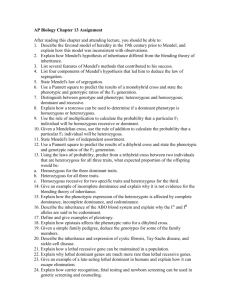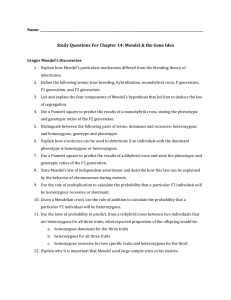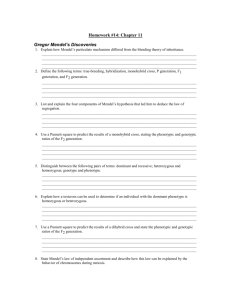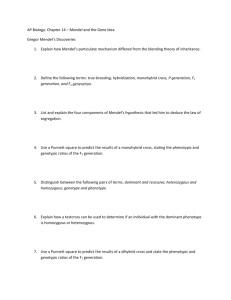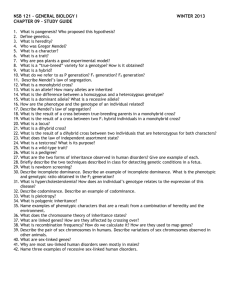Ch. 14 Mendelian genetics
advertisement
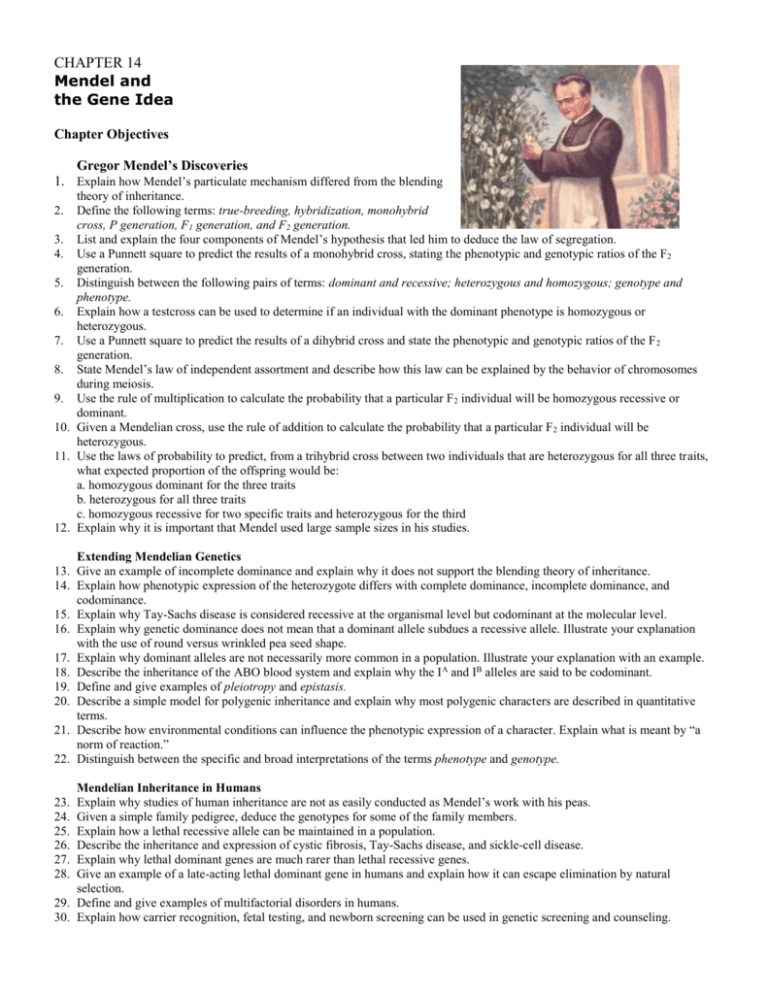
CHAPTER 14 Mendel and the Gene Idea Chapter Objectives Gregor Mendel’s Discoveries 1. Explain how Mendel’s particulate mechanism differed from the blending theory of inheritance. Define the following terms: true-breeding, hybridization, monohybrid cross, P generation, F1 generation, and F2 generation. 3. List and explain the four components of Mendel’s hypothesis that led him to deduce the law of segregation. 4. Use a Punnett square to predict the results of a monohybrid cross, stating the phenotypic and genotypic ratios of the F2 generation. 5. Distinguish between the following pairs of terms: dominant and recessive; heterozygous and homozygous; genotype and phenotype. 6. Explain how a testcross can be used to determine if an individual with the dominant phenotype is homozygous or heterozygous. 7. Use a Punnett square to predict the results of a dihybrid cross and state the phenotypic and genotypic ratios of the F 2 generation. 8. State Mendel’s law of independent assortment and describe how this law can be explained by the behavior of chromosomes during meiosis. 9. Use the rule of multiplication to calculate the probability that a particular F 2 individual will be homozygous recessive or dominant. 10. Given a Mendelian cross, use the rule of addition to calculate the probability that a particular F 2 individual will be heterozygous. 11. Use the laws of probability to predict, from a trihybrid cross between two individuals that are heterozygous for all three traits, what expected proportion of the offspring would be: a. homozygous dominant for the three traits b. heterozygous for all three traits c. homozygous recessive for two specific traits and heterozygous for the third 12. Explain why it is important that Mendel used large sample sizes in his studies. 2. Extending Mendelian Genetics 13. Give an example of incomplete dominance and explain why it does not support the blending theory of inheritance. 14. Explain how phenotypic expression of the heterozygote differs with complete dominance, incomplete dominance, and codominance. 15. Explain why Tay-Sachs disease is considered recessive at the organismal level but codominant at the molecular level. 16. Explain why genetic dominance does not mean that a dominant allele subdues a recessive allele. Illustrate your explanation with the use of round versus wrinkled pea seed shape. 17. Explain why dominant alleles are not necessarily more common in a population. Illustrate your explanation with an example. 18. Describe the inheritance of the ABO blood system and explain why the I A and IB alleles are said to be codominant. 19. Define and give examples of pleiotropy and epistasis. 20. Describe a simple model for polygenic inheritance and explain why most polygenic characters are described in quantitative terms. 21. Describe how environmental conditions can influence the phenotypic expression of a character. Explain what is meant by “a norm of reaction.” 22. Distinguish between the specific and broad interpretations of the terms phenotype and genotype. Mendelian Inheritance in Humans Explain why studies of human inheritance are not as easily conducted as Mendel’s work with his peas. Given a simple family pedigree, deduce the genotypes for some of the family members. Explain how a lethal recessive allele can be maintained in a population. Describe the inheritance and expression of cystic fibrosis, Tay-Sachs disease, and sickle-cell disease. Explain why lethal dominant genes are much rarer than lethal recessive genes. Give an example of a late-acting lethal dominant gene in humans and explain how it can escape elimination by natural selection. 29. Define and give examples of multifactorial disorders in humans. 30. Explain how carrier recognition, fetal testing, and newborn screening can be used in genetic screening and counseling. 23. 24. 25. 26. 27. 28. Key Terms allele amniocentesis carrier character chorionic villus sampling (CVS) codominance complete dominance cystic fibrosis dihybrid dominant allele epistasis F1 generation F2 generation genotype heterozygous homozygous Huntington’s disease hybridization incomplete dominance law of independent assortment law of segregation monohybrid multifactorial norm of reaction P generation pedigree phenotype pleiotropy polygenic inheritance Punnett square quantitative character recessive allele sickle-cell disease Tay-Sachs disease testcross trait true-breeding# Instructor’s Guide for Campbell/Reece Biology, Seventh EditionWord Roots-centesis 5 a puncture (amniocentesis: a technique for determining genetic abnormalities in a fetus by the presence of certain chemicals or defective fetal cells in the amniotic fluid, obtained by aspiration from a needle inserted into the uterus) co- 5 together (codominance: phenotype in which both dominant alleles are expressed in the heterozygote) di- 5 two (dihybrid cross: a breeding experiment in which parental varieties differing in two traits are mated) epi- 5 beside; -stasis 5 standing (epistasis: a phenomenon in which one gene alters the expression of another gene that is independently inherited) geno- 5 offspring (genotype: the genetic makeup of an organism) hetero- 5 different (heterozygous: having two different alleles for a trait) homo- 5 alike (homozygous: having two identical alleles for a trait) mono- 5 one (monohybrid cross: a breeding experiment that uses parental varieties differing in a single character) pedi- 5 a child (pedigree: a family tree describing the occurrence of heritable characters in parents and offspring across as many generations as possible) pheno- 5 appear (phenotype: the physical and physiological traits of an organism) pleio- 5 more (pleiotropy: when a single gene impacts more than one characteristic) poly- 5 many; gen- 5 produce (polygenic: an additive effect of two or more gene loci on a single phenotypic character)Chapter 14 Mendel and the Gene Idea #
